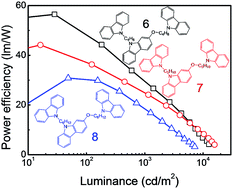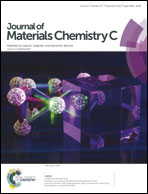Wet-process feasible novel carbazole-type molecular host for high efficiency phosphorescent organic light emitting diodes†
Abstract
Wet-process organic light-emitting diodes (OLEDs) are crucial to realize cost-effective and large-area roll-to-roll fabrication of high quality displays and lightings. In this study, a wet-process feasible carbazole based host material, 2-[4-(carbazol-9-yl)butyloxy]-9-[4-(carbazol-9-yl)butyl]carbazole (6), is synthesized, and two other carbazole hosts, 2-[5-(carbazol-9-yl)pentyloxy]-9-[5-(carbazol-9-yl)pentyl]carbazole (7) and 2-[6-(carbazol-9-yl)hexyloxy]-9-[6-(carbazol-9-yl)hexyl]carbazole (8) are also synthesized for comparison. All the three host materials exhibit high triplet energy, and possess high solubility in common organic solvents at room temperature. On doping a green phosphorescent emitter fac tris(2-phenylpyridine)iridium (Ir(ppy)3) into host 6, the device shows an efficacy of 51 lm W−1 and a current efficiency of 52 cd A−1 at 100 cd m−2 or 30 lm W−1 and 40.7 cd A−1 at 1000 cd m−2. The high efficiency may be attributed to the host possessing an effective host-to-guest energy transfer, the ability for excitons to generate on both host and guest, and excellent film integrity.


 Please wait while we load your content...
Please wait while we load your content...